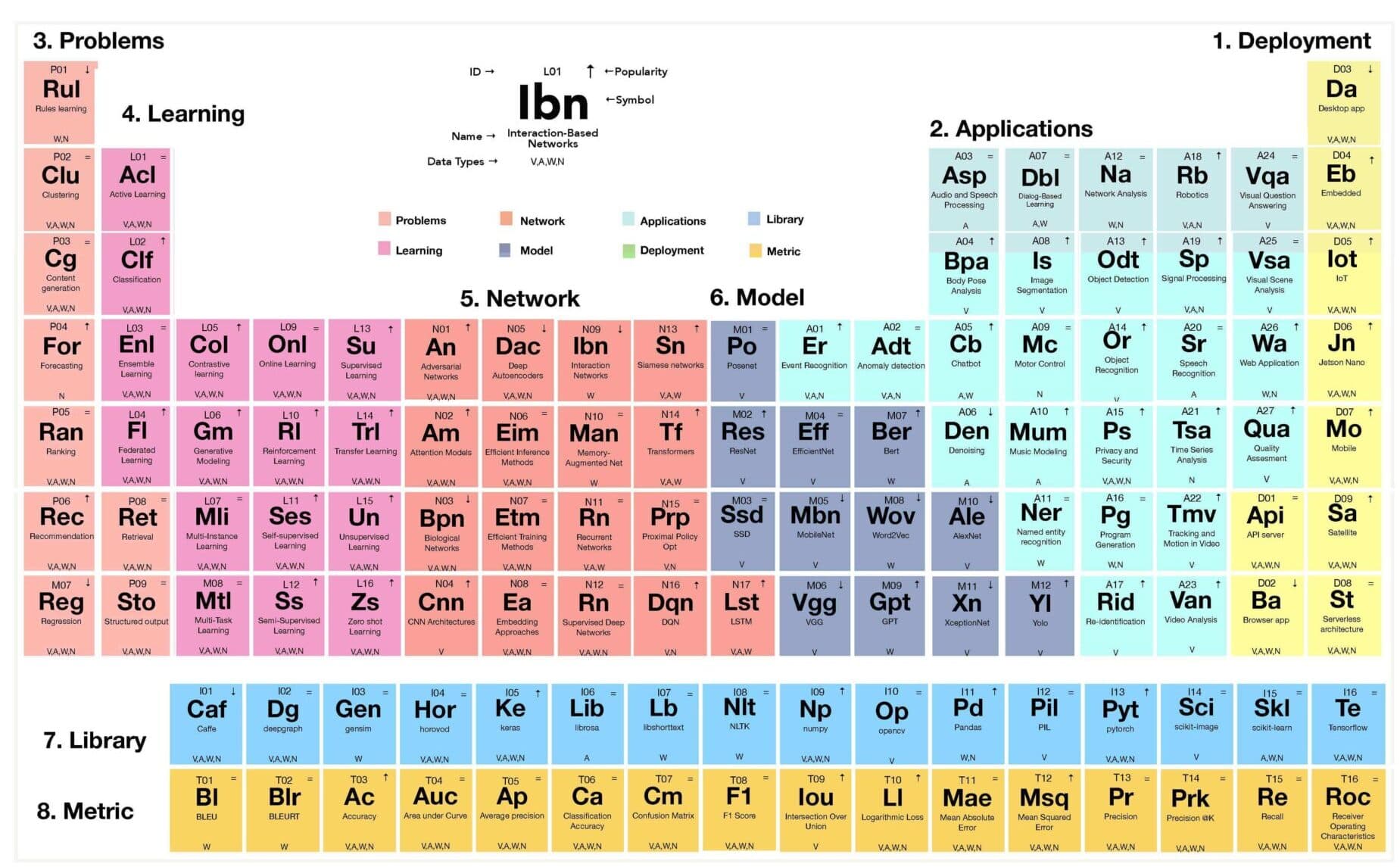5 Steps to Using the Periodic Table of Deep Learning
The Periodic Table of Deep Learning, is a powerful tool that simplifies the complex world of deep learning. Whether you’re starting your first deep learning project or have several under your belt, the chances are that...

The Periodic Table of Deep Learning, is a powerful tool that simplifies the complex world of deep learning.
Whether you’re starting your first deep learning project or have several under your belt, the chances are that you still have many unanswered questions. In this piece, we’re going to explore the 5 steps involved in using our tool for machine learning projects.
Note that before taking the first step in using this tool, a systematic problem and solution analysis should be conducted – the what, why and how of your project.
Step 1 – Define the Input
The first step to think about it is defining the input. Think about the current data at your disposal, or future data your company will have. Separate them into these 4 categories which help to stay focused on the relevant elements:
- V – Visual – images, videos, multi-spec images
- A – Audio – speech and sound
- N – Numerical – time series, etc.
- W – words – textual
Relevant data types for each periodic table element are indicated by the above lettering at the bottom of each element. Categorising your data like this helps filter out the elements of Deep Learning which won’t be applicable to your particular project. This is key in maintaining a well-organised Deep Learning project.
-> ACTION : Select / Tick the relevant data types for your project
Step 2 – Determine Your Goal
Next, consider your desired output and where you want your machine learning model to run—whether in the cloud, on a mobile device, or a desktop application. This choice will impact subsequent architectural decisions.
-> ACTION : Pick the Deployment type from section 1 of the table.
The table helps you analyse different options in different ways. Elements are also ranked by popularity in the field of deep learning showing R&D teams the levels of demand & intrigue associated with them:
↑ Growing in popularity
↓ Decrease in popularity
= Stable popularity
From high demand mobile employment and IoT projects, to less sought after browser and desktop apps, the popularity indicator ensures teams keep their deep learning project relevant and aptly chosen. Even if most of the time people don’t care about the deployment at this early stage of the process, taking into account the limits of your deployment platform is crucial (in terms of memory, latency and computational capacity etc.) in order to wisely select the next steps of your DL pipeline.
Now that deployment has been considered, it’s time to consolidate which deep learning applications are going to be required for the project.
Choose a Deep Learning Application
-> ACTION : pick the most suitable application(s) from section 2 of the table.
Again, popularity within the field could be a contributing factor here to ensure cutting edge technology is being used if applicable. Simply stick to the elements relating to your defined inputs from step 1: V (visual), A (Audio), W (Words) & N (Numbers) and analyse the most appropriate applications of deep learning required. From video analysis to audio and speech processing, or time series analysis to chatbots.
Depending on the nature of your input, a broad list of possible applications can be implemented. E.g. If you have a visual dataset, you could try to classify specific classes, split the dataset into clusters, estimate similarity between image pairs, or generate new images.
Step 3 – Frame the Problem
Now that you know what you’re building, you can start to frame the problem. With some technical know-how the periodic table allows you to select the related problem for your project. Maybe you have a specific quantifiable outcome you want to predict/fit/catch? Then your problem is a supervised learning task like image labelling. Or maybe you want to understand the underlying structures of data? In which case you are dealing with an unsupervised learning task like clustering customer data.
-> ACTION : select no more than 2 / 3 problems from section 3 of the table.
If you have challenges in defining the right problem for your project, get in touch with our team of Deep Learning professionals by booking a free AI clinic here.
Step 4 – Build Your Solution
Here’s where deep learning experts are needed to further analyse the right decision-making for your deep learning project. Unfortunately, deep learning solutions are never black and white. As well as this, bespoke solutions involving combinations of elements from learning techniques, models and networks need to be assessed to solve your agreed upon problem.
Here’s where passing the details of this part of the Periodic Table on to your in-house data science teams or external AI consultants is key.
From there, they can select the optimal combination of :
- Learning strategy,
- Network Type
- Model
- Libraries
These are complex decisions that need careful thinking and a lot of experience.
-> ACTION : get your deep learning experts to select a combination of learning strategies, network types and models from section 4, 5, 6 & 7 of the table.
Again, if you don’t have any inhouse ML skills, get in touch and we can define this with you in an AI clinic.
Step 5 – Monitor Progress
Now to take control of your project. Check out the metrics on the periodic table. Next, ensure you or your data science team can provide the correct metrics to determine the success or failure of your project. These metrics will be a quantitative index through which you evaluate the actual performance of your proposed solution.
Note that with machine learning systems you’ll never find the perfect performance. However you can still keep track of success by the margin of errors seen in your project. In other words, know your metrics but don’t live by them.
-> ACTION : Track the metrics in section 8 of the table to monitor your project.
Final Thoughts
As expected, there are many moving parts in a deep learning project. By using the Periodic Table of Deep Learning Elements R&D managers, product managers, data scientists and software developers can visualise and collaborate on the complexities of these projects as a whole. Download the table for free to explore it yourself.
Want to learn more about starting your deep learning project? Book in for an AI clinic at Gemmo to discuss your project with a team of deep learning experts.



